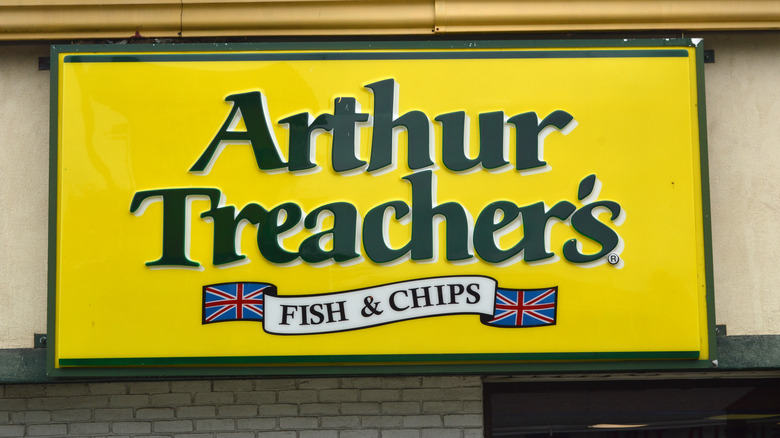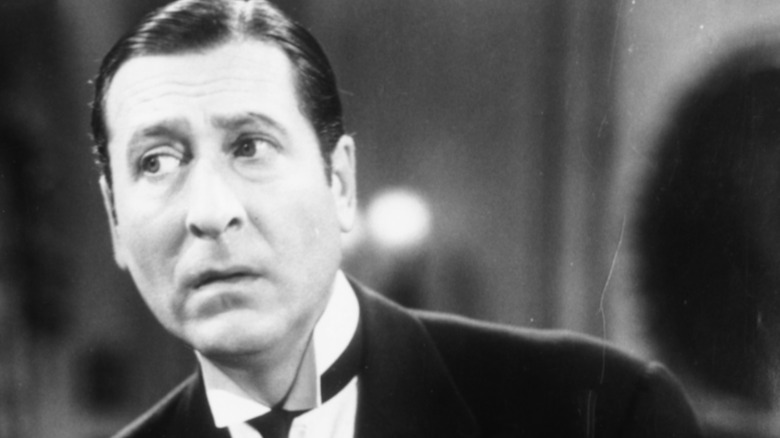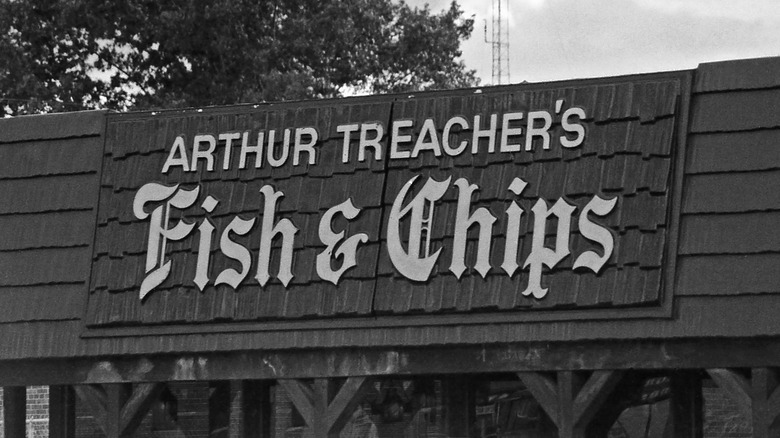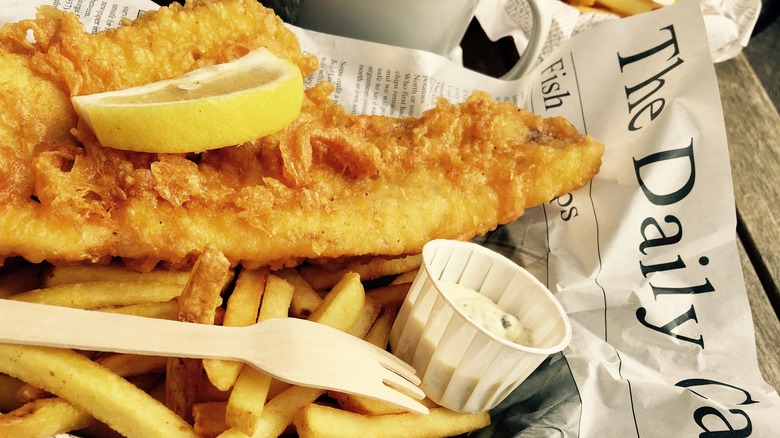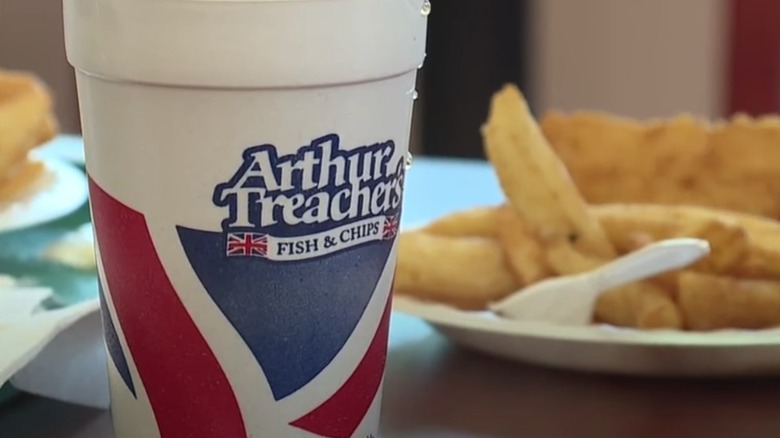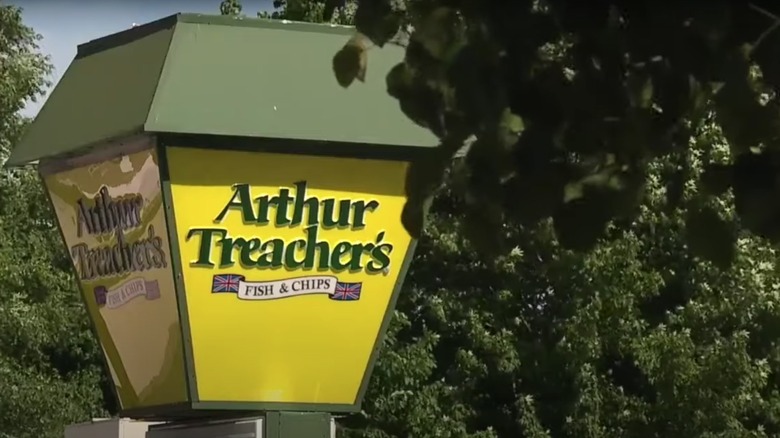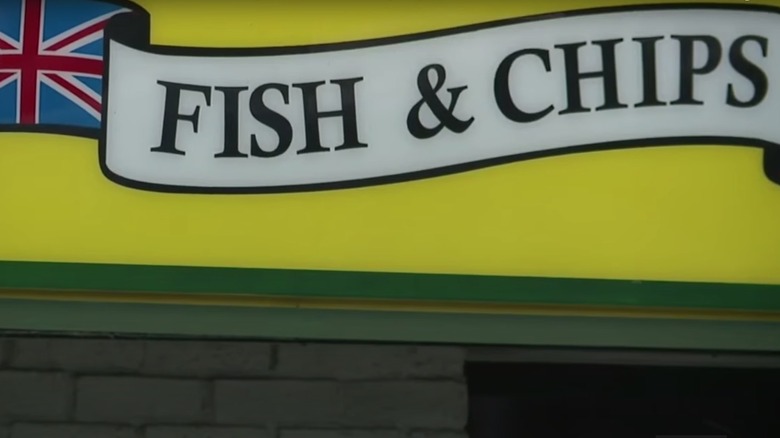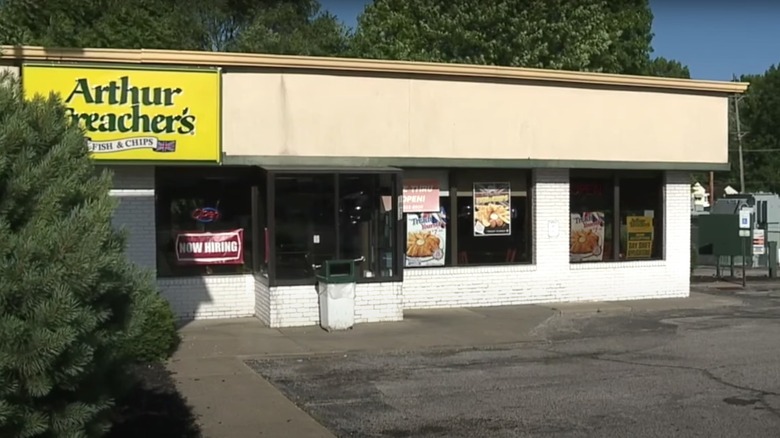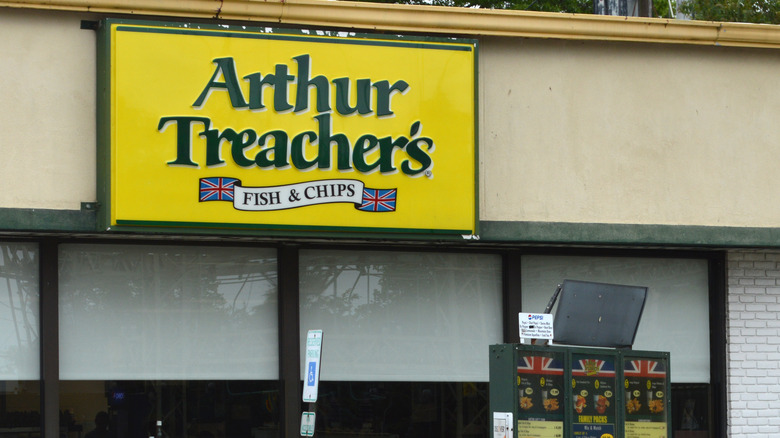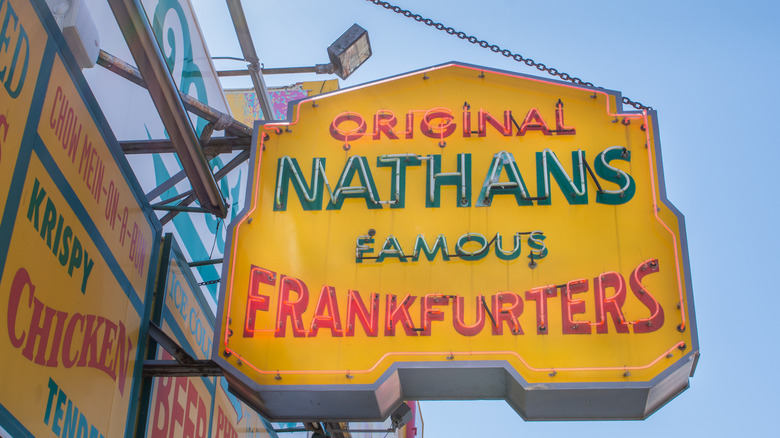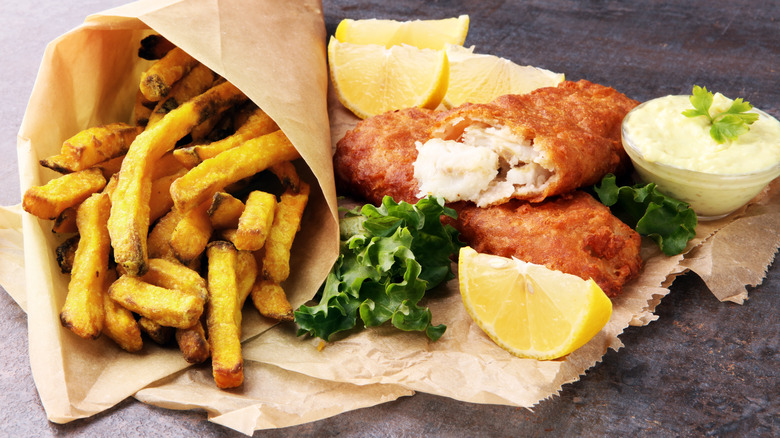The Untold Truth Of Arthur Treacher's
During its heyday in the 1970s, Arthur Treacher's Fish & Chips was America's go-to fast-food restaurant chain specializing in British-style fish and chips. At its peak, recalled a retrospective from MeTV, there were more than 800 Arthur Treacher's locations throughout America, predominantly in the midwest (no surprise, given that the chain's birthplace wasn't jolly old England, but Columbus, Ohio).
As Cleveland's Scene pointed out, Arthur Treacher's became distinctive for serving its signature fish and chips with malt vinegar, a popular condiment in Britain but a somewhat exotic choice stateside. And despite becoming ubiquitous for a brief, shining time, the rise and fall of Arthur Treacher's proved to be a case study in the perils of expanding a fast-food brand too far and too fast. During the 1980s and beyond, the chain increasingly dwindled as location after location shut down. By the 2020s, Arthur Treacher's had become a brand better known for remember-when nostalgia than as a viable dinner option.
However, a unique business partnership announced in the summer of 2021 offered a rare opportunity to resurrect and revive this once widespread brand, introducing the chain's signature deep-fried seafood to a whole new generation. Keep reading to find out more about the untold truth of Arthur Treacher's.
Arthur Treacher was a famous British actor
Those who remember dining at Arthur Treacher's, which officially launched in 1969, may not be aware that the namesake of the fast-food chain was actually a British actor of some renown. Arthur Treacher, who died in 1975 at age 81, enjoyed a long Hollywood career. According to IMDb, Treacher's first screen credit was in 1929, and he went on to appear in dozens of films and movies, often playing a snooty British butler.
When acting roles dryed up in the mid-1960s, Treacher found a new sideline as the announcer/sidekick to talk show host Merv Griffin; Treacher described his role on "The Merv Griffin Show," noted the actor's New York Times obituary, as "partial retirement."
Around the same time, Treacher licensed his name to two business ventures, reported the Times-Tribune: the Call Arthur Treacher Service System and a chain of fish and chip restaurants, the latter deal coming together thanks to the efforts of legendary comedian Bob Hope. As the Cleveland Plain Dealer recalled, Treacher would show up at restaurant openings in a London-style double-decker bus to garner publicity, even though he had no financial stake in the company.
Arthur Treacher's underwent a massive expansion in the 1970s
After its founding in 1969, Arthur Treacher's Fish & Chips underwent a massive expansion. According to Kiplinger, there were 826 Arthur Treacher's restaurants dotted throughout the United States during the peak of the franchise's popularity in the 1970s.
However, during that time, Arthur Treacher's was far from the only fast-food chain attempting to expand nationally. The 1970s, in fact, saw an unprecedented boom in fast food, with numerous competitors entering the fray in hopes of stealing market share away from such industry leaders as McDonald's and Burger King.
The funding behind that expansion was somewhat unconventional. As the Lakeland Ledger reported in 1983, the chain's corporate parent was Orange-co Inc., which had been devoted to citrus growing and the manufacture of orange juice before dipping a toe into fast food with Arthur Treacher's. The expansion that took place between 1972 until 1976 wasn't fueled by actual capital, but with a convoluted leaseback scheme in which Orange-co would find sites for new Arthur Treacher's and sell those sites to investors, who would then agree to a long lease-term This ill-advised business strategy would later come back to haunt Arthur Treacher's.
A fishing dispute between Britain and Iceland undercut Arthur Treacher's hopes of success
While Arthur Treacher's Fish & Chips was expanding rapidly throughout the U.S. during the 1970s, an unexpected confluence of circumstances pulled the rug out from under the chain.
During 1975 and 1976, noted Kiplinger, Arthur Treacher's became an unintended victim in the so-called "cod wars" between Britain and Iceland. As the Washington Post recalled, the two countries had been squabbling for decades about fishing rights in the cod-rich waters off the coast of the nordic nation. When that dispute flared up once again during 1975 and 1976, the resulting escalation led to a drastic rise in the price of Icelandic cod, sending the cost of cod skyrocketing to nearly double what it had been.
This was bad news for Arthur Treacher's. Icelandic cod was a key ingredient in the chain's signature fish and chips; with the cost of the fish now significantly more expensive, that served to put a serious dent in the company's bottom line. With the chain overextended, the timing of the fishing dispute and the resultant effect on cod prices could not have been worse for Arthur Treacher's.
Arthur Treacher's survived chapter 11 bankruptcy — but just barely
As the Lakeland Ledger reported, when Orange-co — corporate owner of Arthur Treacher's Fish & Chips — had funded the chain's unprecedented expansion with its leaseback strategy, the company had "unconditionally guaranteed those leases." Had things gone according to plan, it may well have worked out. Unfortunately, Arthur Treacher's did not become the monumental success that was envisioned. As a result, in 1979 Orange-co sold Arthur Treacher's to Mrs. Paul's Kitchen, a fish-processing company, in the hopes that Mrs. Paul's experience in seafood held the key to making the fast-food chain profitable.
As the York Daily Record recalled, the first thing that Mrs. Paul's executives did was to ditch the high-priced Icelandic cod and switch to pollack, "an oilier fish." Customers, however, noticed the change, and weren't impressed. In 1982, Mrs. Paul's sold the chain to Lumara Foods of America Inc.
Just four months after purchasing Arthur Treacher's, noted the Lakeland Ledger, Lumara Foods opted to file for reorganization under U.S. bankruptcy code, which included Arthur Treacher's. In fact, the biggest factor behind the bankruptcy was the "contingent liabilities" on those leases, which totaled a whopping $61 million.
Arthur Treacher's completely overhauled its business strategy in 2010
By 2010, what was once a nationwide chain with 800-plus restaurants had dwindled down to just 27. According to a report from Columbus Business First at the time, the chain's owners recognized that action clearly needed to be taken. As a result, individual franchisees were no longer permitted to add their own menu items (such as one eatery that served fried bologna), with all 27 restaurants now expected to stick to a uniform menu.
"This is the first time in many years that the franchisees can be confident we can grow the brand," said Gary Occhiogrosso, chief development officer of TruFoods, the new owner of the Arthur Treacher's chain.
The goal, noted Occhiogrosso, was to rebuild the brand via some much-needed marketing efforts in order to get it back into the public consciousness, first regionally in Ohio before expanding that reach nationally once again. However, as consultant Darren Tristano warned, the deep-fried seafood category as a whole wasn't exactly thriving during a period when consumers were increasingly seeking out healthier food choices. "The market has improved," said Tristano, "but no one is having great success in the category."
Arthur Treacher's was in danger of extinction
TruFoods' efforts to revitalize the Arthur Treacher's Fish & Chips brand were well-intentioned, but ultimately futile. As Kiplinger reported, by 2018 there were just seven Arthur Treacher's locations still in business, three in New York City and four more in northeast Ohio.
Interestingly enough, those remaining Arthur Treacher's in Ohio were reportedly doing well, according to a report from the Cleveland Plain Dealer. Arthur Treacher's, the Plain Dealer opined, had become "a place that time forgot, but the people are increasingly coming to remember." Apparently, business tended to boom with Catholic customers at the outset of Lent. "We had a line of people outside waiting for us to open on Ash Wednesday," said Ben Vittoria, owner of an Arthur Treacher's restaurant in Cuyahoga Falls, Ohio.
As Vittoria pointed out, a big part of the popularity of Arthur Treacher's had to do with nostalgia. "It's almost like a cult," he said. "They love the fish and also reliving their memories coming here with their parents or grandparents."
A chain that once had more than 800 restaurants was down to just one
By 2021, the seven Arthur Treacher's Fish & Chips locations had shrunk down to just two. That number was reduced even further, Cleveland's Scene reported, when Ben Vittoria, who owned both surviving restaurants, announced he was closing one of them. With the closure of the Garfield Heights location, that meant that the Cuyahoga Falls restaurant was now the last Arthur Treacher's in the entire country.
"I did not close because business was bad," Vittoria insisted. While admitting that damage inflicted by the COVID-19 pandemic and "corporate mismanagement" were both factors, he blamed "the recent labor crunch" as banging the final nail into the Garfield Heights restaurant. "It has become increasingly difficult to operate our restaurants," he lamented.
As Vittoria explained, when a customer complained about the sloppy state of the dining room in the understaffed eatery, he made the decision to shut the place down on the spot. "We weren't able to do as good of a job as we wanted to and that was very hurtful to me, so we made the decision to close," he said. "If I can't provide the kind of service I want then it's time to retreat."
An Ohio town paid tribute to the chain with Arthur Treacher's Fish & Chips Day
The fact that there was just one Arthur Treacher's Fish & Chips location in America did not go unnoticed by the mayor of the town in which that now-historic restaurant was located.
According to a report from WKSU radio, Cuyahoga Falls mayor Don Walters marked the occasion by designating June 30, 2021 to be Arthur Treacher's Fish & Chips Day in the town. "Well, this is a huge deal, I've been here my whole life I grew up with Arthur Treacher's, and to know that it's the only one in the whole country is amazing," said Walters of his town hosting the one and only Arthur Treacher's in the United States.
For hardcore Arthur Treacher's fan Chris Tarter, having just one restaurant in the entire country represented the end of an era. "Arthur Treacher's is a cornerstone in a lot of the fast foods, and it's just not there," Tarter lamented.
Arthur Treacher's made a comeback thanks to Nathan's Famous
With just one Arthur Treacher's Fish & Chips outlet remaining in 2021, the end of the franchise appeared to be at hand. Or at least that appeared to be the case until one of America's pre-eminent purveyors of hot dogs entered the picture with a big announcement: Nathan's Famous would be placing Arthur Treacher's on the comeback trail.
As the Cleveland Plain Dealer reported, Nathan's Famous announced plans to revive the Arthur Treacher's brand as a "ghost kitchen," with the restaurant's famed fish and chips to be offered online for home delivery from Nathan's Famous.
"We are thrilled to provide operators across the country with the opportunity to add Arthur Treacher's to their portfolio," said Nathan's senior vice president James Walker in a press release, via the Plain Dealer. "Nathan's Famous and Arthur Treacher's have a long-standing relationship and we have worked diligently to keep the brand's traditional menu items while also evolving the menu to fit the Nathan's mantra of 'Craveable, Memorable and Instagrammable' product that we believe both operators and customers will love."
The secret to recreating Arthur Treacher's recipe
During its 1970s heyday, Arthur Treacher's served fish and chips in the authentic British style. In fact, the Cleveland Plain Dealer recalled, Arthur Treacher's reportedly purchased the recipe used by London's Malin's of Bow — which, Londonist explained, may or may not be the first London restaurant to serve fish and chips, but had definitely become the most famous.
Given the scarcity of Arthur Treacher's, it's understandable that experimental fish-loving foodies attempted to recapture the magic in their own kitchens. There are several recipes online, including this one and this one, which highlight two key secret ingredients that are essential to mimic the taste. Those secrets: use pancake mix and club soda to create the batter in which the fish is coated, instead of flour and water.
As Cook's Illustrated explained, a carbonated beverage such as club soda or beer has a different ph level than regular water. As a result, using any carbonated beverage in batter will result in a better-tasting crust, rather than a plain water-based batter.
